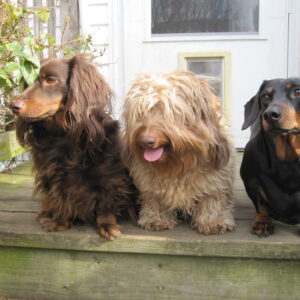Dachshund fun facts are not just entertaining tidbits; they reveal the fascinating world of these unique and beloved dogs. From their quirky origins to their distinctive physical traits, each aspect of a dachshund’s life holds a story worth telling. These little dogs, known for their long bodies and short legs, have captured the hearts of many around the globe. As we dive into their origin stories, explore their unique physical traits, and uncover their personality characteristics, you’ll gain a deeper appreciation for these charming canines. Furthermore, we’ll look at the popular variants of dachshunds, spotlight some famous dachshunds in history, and outline their care needs. You’ll also discover fascinating trivia, their impact on pop culture, and essential training tips that will enhance your relationship with your furry friend. Get ready for a delightful journey into the world of dachshunds!

Dachshund Origin Stories
The Dachshund, often affectionately called the “wiener dog,” has a rich and fascinating history that dates back several centuries. This breed originated in Germany, where it was developed for hunting small game, particularly badgers. The name “Dachshund” itself translates to “badger dog” in German, highlighting its original purpose.
In the early 17th century, these dogs were bred to have a long body and short legs, allowing them to burrow into the ground and chase after their prey. This unique physical trait made them excellent hunters, as they could easily navigate through tunnels and dens.
- The breed gained popularity among nobility and hunters alike for their tenacity and courage.
- During the 19th century, Dachshunds were brought to other parts of Europe and eventually to the United States, where they quickly became beloved family pets.
- World War I and II saw a decline in their popularity due to their German origins, but they made a strong comeback post-war.
Today, Dachshunds are cherished not only for their unique appearance but also for their playful and affectionate nature. Their history as hunting dogs has contributed to their spirited personality and strong instincts.
In summary, the Dachshund’s origin story is one of adaptation and resilience, evolving from a skilled hunter to a beloved companion in homes worldwide.

Unique Physical Traits of Dachshunds
Dachshunds are easily recognizable due to their distinctive physical characteristics. These traits not only contribute to their charm but also to their functionality as a breed.
- Body Shape: Dachshunds have a long, slender body with a pronounced ribcage. This unique shape allows them to burrow into tunnels, originally aiding in their role as hunting dogs.
- Legs: Their short legs are another defining feature. These legs help them navigate through dense underbrush while hunting.
- Head: Dachshunds possess a long, narrow head with a pronounced muzzle. This shape enhances their sense of smell, making them excellent scent hounds.
- Ears: Their long, floppy ears are not just adorable; they help to trap scents, improving their tracking abilities.
- Eyes: Dachshunds have dark, expressive eyes that convey their curious and lively nature.
- Tail: The long, tapered tail is often held high, adding to their overall appearance and helping with balance.
These unique physical traits make Dachshunds not only visually striking but also well-suited for their historical roles as hunters. Their distinctive silhouette is a hallmark of the breed, loved by many.
Dachshund Personality Traits
Dachshunds are known for their unique personalities that make them stand out among dog breeds. Here are some key traits that define their character:
- Playful: Dachshunds have a lively and playful nature. They love to engage in games and activities, making them great companions for families.
- Curious: Their inquisitive nature drives them to explore their surroundings. This curiosity can lead to some funny and adventurous moments.
- Stubborn: While they are intelligent, Dachshunds can be quite stubborn. Training may require patience and consistency.
- Affectionate: These dogs are known for their loyalty and affection towards their owners. They enjoy cuddling and being close to their humans.
- Bold: Despite their small size, Dachshunds have a bold personality. They often exhibit confidence and can be quite protective of their family.
- Vocal: Dachshunds are known to be vocal. They will bark to alert you of any visitors or changes in their environment.

Understanding these personality traits is essential for fostering a strong bond with your Dachshund and ensuring they thrive in their home environment.
Popular Dachshund Variants
The Dachshund breed is known for its distinct appearance and charming personality. Within this breed, several popular variants stand out, each with unique characteristics and appeal. Here are some of the most loved variants:
- Standard Dachshund: This variant is the most recognized. They typically weigh between 16 to 32 pounds and have a sturdy build.
- Miniature Dachshund: Smaller in size, these Dachshunds weigh up to 11 pounds. They are perfect for those who prefer a compact companion.
- Long-Haired Dachshund: With their silky, flowing coats, these Dachshunds have a more elegant appearance. Their hair requires regular grooming.
- Short-Haired Dachshund: This variant has a sleek coat that is easy to maintain. They are known for their smooth and shiny fur.
- Wire-Haired Dachshund: Characterized by their rough, textured coat, these Dachshunds have a distinctive look and require regular brushing to prevent matting.
Each variant brings its own charm and personality to the table. Whether you prefer a miniature or a standard, a long-haired or a wire-haired, there’s a Dachshund for everyone!

Famous Dachshunds in History
Dachshunds have made their mark in history, not just as beloved pets but also as notable figures in various fields. Here are some famous dachshunds that have captured hearts and made headlines:
- Waldi: The first official Olympic mascot, Waldi was a dachshund who represented the 1972 Munich Olympics. This colorful character symbolized the spirit of the games and remains a cherished part of Olympic history.
- Lady and the Tramp: In the classic Disney film, one of the memorable characters is a dachshund named Jock. His charming personality and loyalty to his friends made him a fan favorite.
- Einstein: The adorable dachshund of the famous physicist Albert Einstein, Einstein was known for his playful nature. The bond between them is often highlighted in stories about Einstein’s life.
- Chico: A dachshund who gained fame as a therapy dog, Chico was known for his comforting presence in hospitals and nursing homes, bringing joy to many through his gentle demeanor.
- Winston: This dachshund became famous as the mascot of the 2016 presidential campaign for a well-known candidate. His cute antics and social media presence won the hearts of many supporters.
These famous dachshunds not only showcase the breed’s unique charm but also their ability to connect with people across different walks of life. Whether in sports, film, or as therapy companions, dachshunds have left an indelible mark on history.

Understanding Dachshund Care Needs
Caring for a Dachshund requires attention to their unique needs. These adorable dogs have specific requirements that ensure their health and happiness. Here are some key aspects of Dachshund care:
Diet and Nutrition
Providing a balanced diet is essential for your Dachshund’s well-being. Consider the following:
- High-Quality Dog Food: Choose a high-quality brand that meets their nutritional needs.
- Portion Control: Monitor portion sizes to prevent obesity, a common issue in Dachshunds.
- Regular Feeding Schedule: Maintain a consistent feeding schedule to promote healthy digestion.

Exercise Requirements
Dachshunds have a moderate energy level and need regular exercise to stay healthy:
- Daily Walks: Aim for at least 30 minutes of walking each day.
- Playtime: Engage in interactive play to stimulate their minds and bodies.
- Safe Environment: Ensure your home is safe for them to explore, as they are curious by nature.
Grooming Needs
Grooming is an important part of Dachshund care:
- Regular Brushing: Brush their coat regularly to reduce shedding and maintain coat health.
- Nail Trimming: Keep their nails trimmed to prevent discomfort and injury.
- Ear Cleaning: Check and clean their ears to prevent infections.

Health Care
Regular veterinary visits are crucial for maintaining your Dachshund’s health:
- Vaccinations: Keep their vaccinations up to date.
- Dental Care: Practice good dental hygiene to prevent dental issues.
- Weight Monitoring: Regularly check their weight to avoid obesity-related health problems.
Socialization and Training
Socialization and training are vital for a well-adjusted Dachshund:
- Early Socialization: Expose them to various people, pets, and environments early on.
- Positive Reinforcement: Use positive reinforcement techniques for effective training.
- Consistent Commands: Establish a routine with commands to help them learn.
By understanding and meeting these care needs, you can ensure that your Dachshund leads a healthy and happy life.

Fun and Unique Dachshund Trivia
Dachshunds, often referred to as “wiener dogs,” have a rich history and a variety of interesting facts that make them unique. Here are some fun trivia about these beloved pups:
- Origin of the Name: The name “Dachshund” comes from German, meaning “badger dog.” They were originally bred to hunt badgers!
- Size Variations: Dachshunds come in three sizes: standard, miniature, and even toy! This variety makes them suitable for different lifestyles.
- Colorful Coats: They can have a variety of coat colors and patterns, including dapple, brindle, and piebald, making each one unique.
- Long Lifespan: Dachshunds generally live longer than many other breeds, often reaching 12 to 16 years of age.
- Famous Owners: Many celebrities have owned Dachshunds, including John Wayne, Marilyn Monroe, and Queen Victoria, who had a special fondness for the breed.
- Unique Gait: Their long bodies and short legs give them a distinctive gait, often described as “waddling” when they walk.
- Intelligent and Stubborn: Dachshunds are known for their intelligence, but they can also be quite stubborn, making training a fun challenge!
- Popularity: They consistently rank among the most popular dog breeds in the United States, loved for their playful and affectionate nature.
- World Record: The longest Dachshund ever recorded was 22.5 inches long, showcasing just how unique these dogs can be!
Whether you’re a proud owner or just a fan, these fun facts about Dachshunds highlight their charm and uniqueness!
Dachshunds in Pop Culture
Dachshunds have made their mark in various aspects of pop culture, captivating audiences with their unique charm and personality. From movies to television shows, these adorable dogs have become beloved characters and symbols.
Iconic Appearances in Film and TV
One of the most notable appearances of dachshunds in film is in the animated movie “The Secret Life of Pets”, where a dachshund named Max steals the show with his hilarious antics. Additionally, the classic film “The Wizard of Oz” features a character named Toto, who embodies the loyal and playful nature of dachshunds.
Dachshunds in Literature
Dachshunds have also made their way into literature, with several books featuring these lovable dogs. For instance, the children’s book “The Adventures of Paddington Bear” includes a charming dachshund character that teaches valuable lessons about friendship and loyalty.
Social Media Stars
- Dachshund influencers have taken over platforms like Instagram and TikTok, showcasing their daily lives and adorable personalities.
- Accounts like @dachshundsofinstagram and @wienerdogsofworld have garnered thousands of followers, celebrating the breed’s quirks and charm.
- Don’t forget about @dachshundfacts on instagram
Merchandise and Fashion
Dachshund-themed merchandise is everywhere, from clothing to home decor. Fans can find everything from cute t-shirts featuring dachshund graphics to stylish accessories that show off their love for the breed.
Dachshunds in Art
Artists have long been inspired by dachshunds, creating paintings, sculptures, and illustrations that capture their essence. These artistic representations often highlight their unique shape and playful demeanor, further solidifying their status in pop culture.
In conclusion, dachshunds continue to enchant audiences across various mediums, proving that their popularity is here to stay. Their unique traits and lovable personalities make them a perfect fit for pop culture, ensuring they remain cherished companions and icons for years to come.
Dachshund Behavior and Training Tips
Training a Dachshund can be a rewarding experience, but it requires patience and understanding of their unique behavior. Here are some essential tips to help you train your furry friend effectively.
Understanding Dachshund Behavior
Dachshunds are known for their independent nature. This trait can make training a bit challenging, but with the right approach, you can achieve great results.
- Socialization: Early socialization is key. Expose your Dachshund to various people, pets, and environments to help them become well-adjusted.
- Positive Reinforcement: Use treats, praise, and playtime as rewards for good behavior. This encourages them to repeat those behaviors.
- Consistency: Be consistent with commands and rules. This helps your Dachshund understand what is expected of them.
Training Tips
Here are some effective training tips specifically for Dachshunds:
- Short Sessions: Keep training sessions short, around 5-10 minutes. Dachshunds can lose interest quickly.
- Basic Commands: Start with basic commands like “sit,” “stay,” and “come.” These are essential for good behavior.
- Leash Training: Teach your Dachshund to walk on a leash without pulling. Use a harness if necessary, as their long backs can be sensitive.
- House Training: Be patient and use a consistent schedule for bathroom breaks. Take them out frequently, especially after meals.
Addressing Behavioral Issues
If your Dachshund displays unwanted behaviors, consider the following:
- Barking: Dachshunds can be vocal. Teach them the “quiet” command and reward them when they stop barking.
- Separation Anxiety: Gradually get your Dachshund used to being alone. Start with short periods and gradually increase the time.
- Digging: If your Dachshund digs, provide them with a designated digging area. Redirect their behavior to this spot.

With time, love, and patience, your Dachshund can become a well-behaved and cherished member of your family. Remember, training is an ongoing process, and consistency is the key to success!




